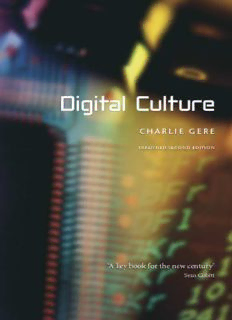
Digital Culture - Media Arts Cultures Media Arts Cultures PDF
Preview Digital Culture - Media Arts Cultures Media Arts Cultures
Digital Culture charlie gere expanded second edition ‘A key book for the new century’ SeanCubitt Digital Culture Digital Culture charlie gere reaktion books For Stella Published by Reaktion Books Ltd 33Great Sutton Street, London ec1v 0dx, uk www.reaktionbooks.co.uk First published 2002, second edition2008 Copyright © Charlie Gere 2002, 2008 All rights reserved No part of this publication may be reproduced, stored in a retrieval system, or transmitted, in any form or by any means, electronic, mechanical, photocopying, Recording or otherwise without the prior permission of the publishers. Printed and bound in Great Britain by cpi/Antony Rowe, Chippenham, Wiltshire British Library Cataloguing in Publication Data: Gere, Charlie Digital Culture. –Rev and updated ed. 1 Digital electronics – Social aspects 2. Computers and civilization I. Title 303.4'834 isbn:978 1 86189 388 8 Contents Preface to the second edition 7 Introduction: What is Digital Culture? 11 1 The Beginnings of Digital Culture 21 2 The Cybernetic Era 51 3 The Digital Avant-garde 79 4 The Digital Counter-culture 116 5 Digital Resistances 154 6 Digital Nature 201 7 Digital Culture in the Twenty-first Century 207 References 225 Acknowledgements 237 Photographic Acknowledgements 238 Index 239 preface to the second edition The second edition of a book offers the author the chance to reflect on changes that have taken place since the first edition was published. In the case of Digital Culture this means trying to think about some of the most dramatic and important transformations that are the result of the increasing ubiquity and importance of digital technologies. I believe that the underlying argument of the book – that people (in the ‘developed’ world at least) increasingly live in a ‘digital culture’ – holds true. Indeed I would suggest that this is more clearly the case than when I started writing about the subject back in the mid-1990s. To some extent our culture is becoming so thoroughly digital that the term digital culturerisks becoming tauto- logical. One of the concomitants of our current digital culture is the sense of rapid change. Everything is of course always changing all the time. Change appears to be a given of existence, whether it is manifested in the universal tendency towards entropy, or in the glacially slow drift of evolutionary change. The only thing that never changes is that everything always changes. Mostly this process of change is slow enough to be imperceptible, other than in retrospect, or by implica- tion. But for the beings that Nietzsche so dismissively characterized as ‘some clever animals’ in a ‘remote corner of the universe’ things appear to be changing very fast, perhaps too fast. The reason for this 7 rapid change is the animals’ extended and augmented capacity to manipulate their environment through their technological prosthe- ses, from flint tools through to computers. It is this capacity alone that distinguishes the clever, human animals from the other, less clever, species that share the same world. The human is only human in so far as it is technical. Technology is not a product of human beings. It is a precondition of their existence. It is technology that has enabled humans to be clever, or at least to think of themselves as such. It is also technology that appears to have brought them poten- tially to the brink of their own annihilation, whether through nuclear war or global warming, which is not clever. It is the increasingly rapid development and complexity of tech- nology that is making things change so rapidly. Our technologies are always in the process of changing us and our relationship with our environment. The difference is the rate at which this change is taking place. For the first few million years of hominoid and human tool use, change would have been more or less imperceptible. Then, within the last twenty to thirty thousand years, developments started to pick up pace. By the time we arrive at the modern era, technology is developing at an incredible rate (for those of us in the ‘developed’ world at least). Finally, the last one hundred or so years have seen more and more rapid technological change and development than in all of previous human history. If it was possible to plot this rate of development on a graph, with technological complexity on the vertical axis and time on the horizontal, then the likely result would be a line that barely crept above the base line until it almost reached the further edge, at which point it would curve dramatically, until it was almost vertical. It would show that the rate of technological development is exponential, in that it grows in relation to its size. One of the results of this accelerating rate of growth is that it is increasingly hard, if not impossible, for us to fully grasp what is going on. Though most of us are aware of other technological developments 8 Digital Culture
Description: